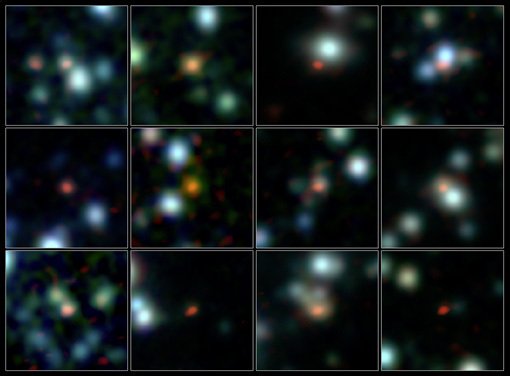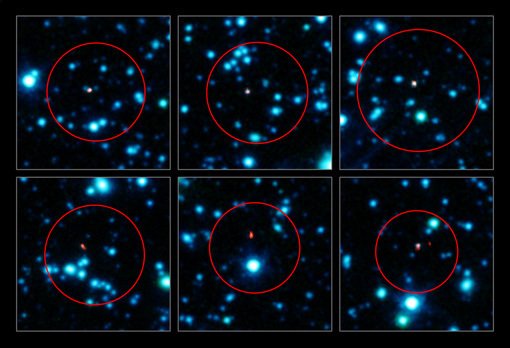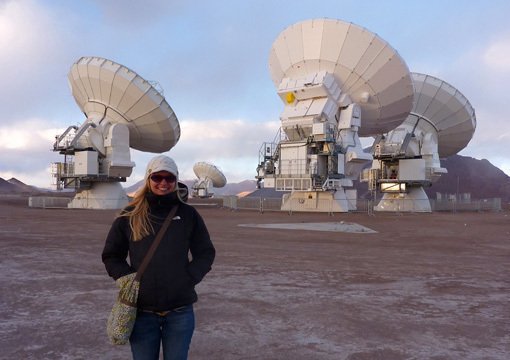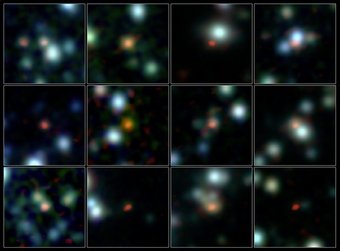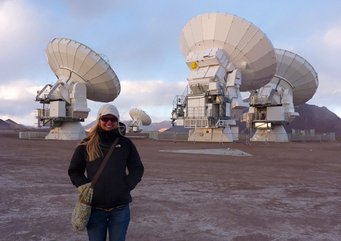Pinpointing the most fertile galaxies in the universe
Using the compound telescope ALMA, a team of researchers has pinpointed the positions of more than 100 of the most fertile star-forming galaxies. The precise position measurements clear up a mystery about the observed productivity of these objects. They also show that previous studies of these objects have often suffered from mis-identifications, and how precise measurements like these new results avoid this kind of error.
| Background information | Questions & Answers | Image download |

Diese Zusammenstellung zeigt Nahaufnahmen einer Auswahl dieser Galaxien. Die ALMA-Aufnahmen im Submillimeterbereich (rot und orange dargestellt) wurden dabei über eine Infrarotaufnahme (in blau dargestellt) der IRAC-Kamera des Spitzer-Weltraumteleskops gelegt.
Vorangehende Beobachtungen waren nicht detailscharf genug gewesen, um diese Galaxien eindeutig in Aufnahmen aus anderen Wellenlängenbereichen zu identifizieren.
Submillimeter galaxies, discovered in the late 1990s, produce so many new stars as to be responsible for a significant fraction of the total energy output of all galaxies over the course of all of cosmic history. A side effect of having many (and many massive) stars is the production of lots of dust. And indeed, in the most extreme cases, these fertile galaxies are so deeply shrouded in dust they are effectively hidden from sight for astronomers observing in visible light. That is why, in order for a full census of these objects, and to reliably gauge their star formation activity, astronomers need to resort to submillimeter observations. Additional information can come from observations using infrared radiation or radio waves.
Previous submillimeter surveys of these distant objects suffered from a lack of detail. But now, a team led by Ian Smail (Durham University, UK) has completed a large, yet highly detailed survey of more than 100 such objects using the international compound telescope ALMA (Atacama Large Millimeter/Submillimeter Array), located in Chile, at a resolution more than a factor 10 better than previous surveys. The observations, targeting a region known as the Extended Chandra Deep Field South in the Southern constellation Fornax, made use of 15 of ALMA's antennas, which were combined to act as a single, large telescope.
The new survey's high-resolution images for a large number of galaxies have helped to solve one apparent mystery concerning submillimeter galaxies. Alexander Karim (Argelander Institute for Astronomy, Bonn and Durham University, UK) explains: "We previously thought the brightest of these galaxies were forming stars more than a thousand times more vigorously than our own galaxy, the Milky Way, putting them at risk of blowing themselves apart. But instead of single, hyperactive galaxies, the ALMA images revealed multiple, smaller galaxies, each forming stars at a more reasonable rate." Karim, formerly a PhD student at the Max Planck Institute for Astronomy, is a member of the survey team and lead author of the paper reporting this key result of the survey.
The newly published survey also promises to put future studies of submillimeter galaxies onto a solid footing. Jacqueline Hodge of the Max Planck Institute for Astronomy, lead author of the survey paper, explains: "Astronomers use many different kinds of light to examine celestial objects. But this only works if you know precise positions – only then can you say 'Yes, this blob here in my infrared image represents the same object as that blob there in my submillimeter image'. Our survey shows that previous attempts to identify the infrared and radio counterparts of submillimeter galaxies were considerably error-prone, leading to incorrect identifications in about a third of all cases. With our precise submillimeter position measurements, such errors can be avoided."
The work by Smail, Hodge, Karim and their colleagues has prepared the stage for the next logical step: Examinations at even higher resolution, deploying the full power of the completed ALMA array with all of its 66 antennas, could help elucidate the nature of submillimeter galaxies. The most plausible scenario is that submillimeter galaxies are created when large galaxies collide, their mutual gravitational pull triggering an intense phase of star formation. High-resolution images could show aspects of those galaxies' shapes, and possibly traces of the collision process itself.
Background information
The ESO press release about the new ALMA results can be accessed here.
The survey paper is accepted for publication as Hodge et al., "An ALMA Survey of Submillimeter Galaxies in the extended Chandra Deep Field South: Source Catalog and Multiplicity" in the Astrophysical Journal.
The paper by Karim et al., "An ALMA survey of submillimetre galaxies in the Extended Chandra Deep Field South: High resolution 870 µm source counts" is accepted for publication in the Monthly Notices of the Royal Astronomical Society.
The team members are J. A. Hodge (Max-Planck-Institut für Astronomie Heidelberg, Germany [MPIA]), A. Karim (Institute for Computational Cosmology, Durham University, United Kingdom [Durham]), I. Smail (Durham), A. M. Swinbank (Durham), F. Walter (MPIA), A. D. Biggs (ESO), R. J. Ivison (UKATC and Institute for Astronomy, University of Edinburgh, Edinburgh, United Kingdom), A. Weiss (Max–Planck Institut für Radioastronomie, Bonn, Germany [MPIfR]), D. M. Alexander (Durham), F. Bertoldi (Argelander–Institute of Astronomy, Bonn University, Germany), W. N. Brandt (Institute for Gravitation and the Cosmos & Department of Astronomy & Astrophysics, Pennsylvania State University, University Park, USA), S. C. Chapman (Institute of Astronomy, University of Cambridge, United Kingdom; Department of Physics and Atmospheric Science, Dalhousie University, Halifax, United Kingdom), K. E. K. Coppin (McGill University, Montreal, Canada), P. Cox (IRAM, Saint–Martin d'Héres, France), A. L. R. Danielson (Durham), H. Dannerbauer (University of Vienna, Austria), C. De Breuck (ESO), R. Decarli (MPIA), A. C. Edge (Durham), T. R. Greve (University College London, United Kingdom), K. K. Knudsen (Department of Earth and Space Sciences, Chalmers University of Technology, Onsala Space Observatory, Onsala, Sweden), K. M. Menten (MPIfR), H.–W. Rix (MPIA), E. Schinnerer (MPIA), J. M. Simpson (Durham), J. L. Wardlow (Department of Physics & Astronomy, University of California, Irvine, USA) and P. van der Werf (Leiden Observatory, Netherlands).
The Atacama Large Millimeter/submillimeter Array (ALMA), an international astronomy facility, is a partnership of Europe, North America and East Asia in cooperation with the Republic of Chile. ALMA is funded in Europe by the European Southern Observatory (ESO), in North America by the U.S. National Science Foundation (NSF) in cooperation with the National Research Council of Canada (NRC) and the National Science Council of Taiwan (NSC) and in East Asia by the National Institutes of Natural Sciences (NINS) of Japan in cooperation with the Academia Sinica (AS) in Taiwan. ALMA construction and operations are led on behalf of Europe by ESO, on behalf of North America by the National Radio Astronomy Observatory (NRAO), which is managed by Associated Universities, Inc. (AUI) and on behalf of East Asia by the National Astronomical Observatory of Japan (NAOJ). The Joint ALMA Observatory (JAO) provides the unified leadership and management of the construction, commissioning and operation of ALMA.
Questions and Answers
Why does the presence of massive stars imply the presence of dust?
Most cosmic dust is produced in the late stages of the evolution of massive stars. As these stars' atmospheres expand (in particular in the "Asymptotic Giant Branch" stage), molecules can cluster together. For the right kinds of molecules, this results in the formation of dust grains. Stellar winds blow those dust grains into the wider neighbourhood. Supernova remnants, which are formed in the explosions ending the life of massive stars, are also candidate loci for dust production. Vigorous star formation means the formation (among others) of many massive stars, and thus significant dust production rates. This is a plausible mechanism for how submillimeter galaxies have acquired their dust; however, alternative scenarios in which the galaxy is dusty even before its excessive star-formation activity also exist, and the question is not yet settled definitely.
Why were these specific submillimeter galaxies targeted?
The survey targeted galaxies that had previously been detected with a survey using the APEX telescope, a single-dish telescope at the same location as ALMA. That survey, the LABOCA ECDFS Submillimeter Survey (LESS), had in turn chosen that specific location, the Chandra Deep Field South, because it is one of the best studied regions in the Southern sky.
Why could previous surveys not show fine details?
The amount of detail a telescope can see – its resolution – depends on the telescope's size: The larger the telescope, the finer the details that can be resolved. Before ALMA, submillimeter astronomers had two options. For large-scale surveys, they could only use single-dish telescopes (such as the APEX telescope in Chile) that promised moderate resolution at best. For higher resolution, they could turn to arrays such as the Plateau de Bure Interferometer in France. But the comparatively low sensitivity of those arrays meant that considerable time would need to be spent observing each particular source. In a world where competition for telescope time is fierce, this effectively meant that only very few submillimeter galaxies could be studied at high resolution.
ALMA represents a considerable boost in resolution and sensitivity at the same time – even in its preliminary configurations, with less than a quarter of its eventual 66 antennae. In the configuration used for this survey, ALMA has the same resolution as a single radio dish with a diameter of 125 meters. This is a factor 10 better than for the best previous survey, which used the APEX telescope: a single 12 meter dish. The new survey has a resolution of 1.6 arcseconds, as compared to nearly 20 arcseconds for APEX. And thanks to its high sensitivity, ALMA needed a mere two minutes to complete observations for each of the galaxies in the survey, making large-scale surveys feasible.
Why was the hyperactivity of the galaxies considered a problem?
Stars emit intense radiation. In order to collapse and form new stars, clouds of matter need to collapse. Sufficiently intense radiation can disrupt star formation by heating up matter and/or dispersing existing dense clouds. From model calculations, the early values of the order of 1000 solar masses' worth of material being transformed into stars every year was precariously close to that limit, raising the question whether or not such high rates were physically possible. Now that those particular sources have been resolved, showing that in each of these cases, the radiation is coming not from one galaxy, but from two galaxies with somewhat lower individual star formation rates, the problem has found an elegant solution.

In dieser Zusammenstellung sind sechs dieser Galaxien (in rot dargestellt) aus den scharfen, neuen Aufnahmen von ALMA gezeigt. Die ALMA-Aufnahmen im Submillimeterbereich wurden über eine Infrarotaufnahme (in blau dargestellt) der IRAC-Kamera des Spitzer-Weltraumteleskops gelegt.
Die großen, roten Kreise zeigen die Regionen an, in denen die Galaxien in einer vorangehenden Durchmusterung mit dem APEX-Teleskop detektiert worden waren. Dessen Bilder erreichten freilich nicht die nötige Schärfe, um die eigentlichen Galaxien eindeutig zu identifizieren, so dass viele mögliche Kandidaten im roten Kreis auftauchen.

Download area



